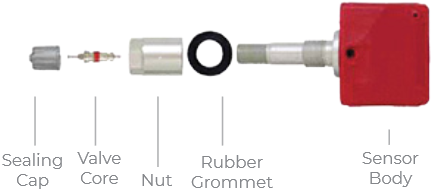|
STANDARD MOTOR PRODUCTS QS106R
|
|
$23.79
Price
|
$0.00
Core
|
+ Sold in packs of 1x1
Pack
|
$23.79
Total
|
|
|
|
|
|
| STANDARD MOTOR PRODUCTS QS106R Specifications |
|---|
| Battery -powered | Yes | | Core Material | Nickel Coated Core | | Inflation Valve Type | Rubber | | Mounting Hardware Included | Yes | | Mounting Location | Wheel | | Mounting Method | Snap in |
|
|
| QWIK-SENSOR Multi-Frequency; 314.9, 315, and 433/434 MHz |
This sensor is blank and requires programming before installation.
- Available for both Domestic and Import applications
- Combines 314.9, 315, and 433/434 MHz applications into one
single SKU
- Factory-installed rubber valve stem interchangeable metal,
chrome, black valves available separately
- Required sensor programming can be completed before or after
installation, and while under pressure
- Surface-mounted dual band antenna ensures signal integrity and
reliability without compromising battery life to ensure data is
transmitted accurately
- Longer battery life power consumption reduced up to 30
percent
- Faster programming times
- Application Specific Integrated Circuit (ASIC) features an
accelerometer that uses multi-axis positioning which allows the
TPMS system to accurately display POD (Pressure on Demand)
Rubber (Snap-In) Installation: A rubber-enclosed valve piece is "snapped in" to the body with a valve screw.

Metal Valve (Clamp-In) style TPMS Sensors have higher speed ratings (typically up to 155 mph) than Rubber Valve (Snap-In) styles (typically up to 115 mph).
Metal (Clamp-In) Installation: The valve piece is attached to the sensor body, and the valve core is secured with a nut and rubber grommet.

 Program vs. Clone vs. Relearn Don't confuse TPMS Sensor Relearning, Programming and Cloning! Some processes require a Tire Pressure Monitoring System (TPMS) Programming Tool to complete, but not all processes are required (or available) for every application.
| PROGRAM |
Required only for Universal (Programmable) Sensors, in addition to TPMS Sensor Relearning. A TPMS Tool is required to:
- Program the specific Year/Make/Model protocol for the vehicle into the sensor
- Create or Clone a sensor ID onto the sensor
BEFORE INSTALLATION |
| CLONE |
Ideal for drivers who frequently swap wheels/tires, such as during the winter season. A relearn procedure is not required when sensors are cloned. A TPMS Tool is required to:
- Copy/Clone the unique ID from the original TPMS Sensor to the replacement sensor
BEFORE INSTALLATION |
| RELEARN |
Required when a new (not cloned) sensor ID is introduced or when the tires are rotated. A TPMS Tool may be required to:
- Write the unique sensor IDs to the vehicle's computer
- Assign the IDs to the correct wheel position (for vehicles that display pressure by location)
AFTER INSTALLATION |
|
| OEM / Interchange Numbers: QS101R, QS102R, QS103R, QS104R, QS105R |
|